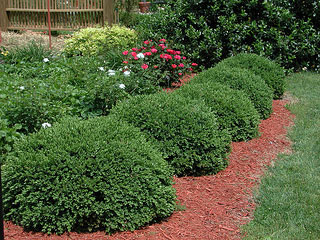Resource Library
Plant of the Week: Boxwood, Green Velvet
Boxwood, Green Velvet -- Green Velvet boxwood may be slow growing but it is worth the wait. (Image courtesy Gerald Klingaman)
Green Velvet Boxwood
Latin: Buxus Green Velvet
Learning plants requires interest, a bit of dedication and enough difference between
them that you can recognize them as individuals. Boxwoods have always perplexed me
so too often I’ve relegated them to one of my mental subcategories – another green
meatball. However, such treatment is a disservice to some fine plants such as Green
Velvet Boxwood (Buxus ‘Green Velvet’).
‘Green Velvet’ and its two siblings ‘Green Gem’ and ‘Green Mountain’ are hybrids between
the Korean boxwood (Buxus sinica var. insularis) and the common boxwood (B. sempervierens). The
original open pollinated crosses were made at Sheridan Nursery Company in Oakville,
Ontario, Canada, during the 1960s. A row of each species was planted side by side
with seeds collected from the Korean boxwood parent. The seeds were planted and the
resultant thousands of seedlings grown and observed for about a decade before the
three distinct forms were introduced between 1973 and 1975. The main selection criterion
was choosing plants with good green wintertime foliage color.
The Korean boxwood was introduced into North America in 1922. It is a compact growing
shrub seldom over 6 feet tall and wide with the most cold-hardiness of the boxwoods,
tolerating winter temperatures in the minus 25-degree Fahrenheit range. Common boxwood,
introduced from Europe before 1650, is a large shrub often growing over 10 feet tall.
This species is typically killed by temperatures much below minus 10 degrees Fahrenheit. But
common boxwood has better foliage color in the summer and winter than Korean boxwood
which tends to turn shades of orange-yellow in the winter, especially when planted
in an exposed site.
The hybrid boxwoods inherited the dwarf size and increased winter hardiness of the
Korean boxwood and the compact growth habit and better winter foliage color of the
common boxwood. Specifying a size for a boxwood selection is problematic because they
just keep growing if left unpruned, eventually exceeding the 15-year-old plant size
that seems to be the favored reference point for listing size.
‘Green Velvet’, probably the most common of the three introductions from Sheridan,
is often listed as a 3-foot-tall, 4-foot-wide plant. But many of the original now
40-year-old plants are now 6 feet in height. ‘Green Mound’ is listed as a 3-by-3-foot
tall, mounded plant, while ‘Green Mountain’ is an upright growing form especially
suitable for hedging that reaches 5 feet in height with a spread of 3 feet.
These hybrid boxwoods are tough, adaptable plants that can be grown from zone 4 through
zone 8. They not only have good cold tolerance, but they have surprisingly good tolerance
to heat and humidity, making them amongst the most commonly seen boxwoods in the South. Ideally
boxwoods should have a good, rich, well drained soil, but if heavy clay is all that
is available, they will grow in that too.
The winter discoloration problem has not been completely solved with these selections
but they are greener, longer than the Korean parent. They can be grown in full sun
or light shade but locations where there is some wintertime shade and protection from
strong, cold winds will help minimize winter discoloration. Like all boxwoods, these
hybrids stand pruning well and can be maintained at almost any size. Heavy pruning
should be delayed until just before bud break in the spring. Light shearing can be
administered as needed during the growing season.
Boxwoods get a long list of pests and diseases, but these hybrids seem to be less
susceptible to ailments than the common boxwood.
By: Gerald Klingaman, retired
Retired Extension Horticulturist - Ornamentals
Extension News - November 27, 2013
